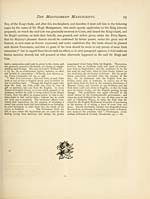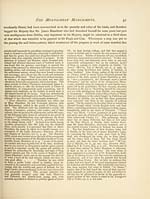Montgomery manuscripts
(44) Page 30
Download files
Complete book:
Individual page:
Thumbnail gallery: Grid view | List view

3Q
The Montgomery Manuscripts.
chapter III.
OW these affairs, as also Con's escape and journey with Sir Hugh, and their errand, took
time and wind at Court, notwithstanding theirs (and the said George's) endeavours to
conceal them from the prying courtiers (the busiest bodies in all the world in other men's
matters, which mayprofit themselves), so that in the interim one Sir James Fullerton, 1 a great favourite,
who loved ready money, and to live in Court, more than in waste wildernesses in Ulster, and after-
wards had got a patent clandestinely passed for some of Con's lands, 2 made suggestions to the King
that the lands granted to Sir Hugh and Con were vast territories, too large for two men of their
degree^ and might serve for three Lords' estates, and that his Majesty, who was already said to be
1 Sir fames Fullerton. — It is rather remarkable that
the particular branch of the Fullerton family to which sir
James belonged has not been discovered, although he was
probably a native of the parish of Dundonald in Ayrshire,
where the Fullertons have resided numerously since the
time of David II. He was, no doubt, of humble origin,
and had made his own way into a distinguished position,
else we should have certainly heard something of his
family history. Commencing in the humble capacity of a
teacher, in connexion with his friend, James Hamilton, he
became eminently distinguished as a political agent of
James I., occupying several high and lucrative places,
after the accession of that king to the English throne, and
receiving extensive grants of lands both in this country
and in England. In establishing his school at Dublin in
1587 (to which he appears to have brought Hamilton as
an assistant), there is no evidence that he had any other
object or design, than simply to discharge the duties of a
teacher. When Fullerton and his associate had become
well-known in Dublin, and by their talents and popularity
contributed in some degree to make Scotland and Scots-
men respected in this country, James VI. secured their
service as political agents, and through them, smoothed
the way for his acceptance by the Irish leaders, when he
should be admitted, on the death of Elizabeth, to the Eng-
lish throne. In both cases the king was most fortunate in
the choice of his men, and he afterwards acknowledged
their services in a very liberal manner. Fullerton
received the honour of knighthood on the accession of
James, and lived at the English court, holding among other
appointments those of gentleman of the bed-chamber,
master of the privy purse to the duke of York, governor
to the young prince, and master of the court of wards
and liveries. For notices of the various offices to which
he was appointed in Ireland, and of the very extensive
grants received by him, of lands in this country, the reader
may consult Erck's Repertory of the Inrolments of the
Patent Rolls of Chancery in Ireland, vol. i., part ii. , pp.
22, 39, 40, 41, 78, go, 102, 249, 262. Of Fullerton's
marriage, we have the following notice, in a letter written
by Margaret Hay, countess of Dunfermline, to the countess
of Eglinton, on the 2nd March, 1614: — "No newis (news)
for sartintie, but ser James Fullartine is to be merit with
my ladie Kellos, it is dowin or now." — Fraser, Memorials,
vol. i., p. 195. Sir James died in 1630, without issue,
and bequeathed his property to his "deare and well-beloved
wife, the lady Bruce. " Her brother, Thomas, lord Bruce,
baron Kinloss, was his sole executor. — M'Crie, Life of
Melville, vol. ii. , p. 294. Thomas Bruce above-named was
the third baron Kinloss. His father, Mr. Edward Bruce,
of Clackmannan, obtained a grant of the lands which had
belonged to Kinloss Abbey, and was created baron Kin-
loss in 1601. His elder son, Edward, the second baron,
was killed in a duel, at Bergen-op-Zoom, by sir Edward
Sackville, in 1613. The narrative of that celebrated and
bloody affair, as given by Sackville, afterwards earl of Dor-
set, may be found in the Guardian, Nos. 129 and 133.
On the death of lord Edward, without issue, his title and
estates went to his younger brother Thomas above-
mentioned, who, in 1633, was created earl of Elgin. New
Slat. Account of Scotland, County of Elgin, p. 205 ;
Chambers, Domestic Annals of Scotland, vol. i. , pp. 447
—45°-
2 For some of Con' s lands. — We have not been able to
discover the names of these lands. Sir James Fullerton
had lands and tenements granted by the crown, in the
counties of Westmeath, Cork, Antrim, Tipperary, Water-
ford, Sligo, Dublin, Roscommon, Kildare, Queen's County,
Limerick, and Donegal, but none in the county of Down.
His Antrim grants lay principally in the towns of Car-
rickfergus and Larne. Calendar of Patent Rolls, James I. ,
pp. 7, 8. The absence of any record of such lands in the
Patent Rolls, as those referred to in the text, may be
accounted for by the grant having been irregularly or
clandestinely obtained.
3 For two men of their degree. — This argument of sir
James Fullerton was probably the one which had most
weight with the king in making up his mind to set aside
the original compact between Con and sir Hugh at Braid-
stane. P. 27, supra. It was found that a grand
The Montgomery Manuscripts.
chapter III.
OW these affairs, as also Con's escape and journey with Sir Hugh, and their errand, took
time and wind at Court, notwithstanding theirs (and the said George's) endeavours to
conceal them from the prying courtiers (the busiest bodies in all the world in other men's
matters, which mayprofit themselves), so that in the interim one Sir James Fullerton, 1 a great favourite,
who loved ready money, and to live in Court, more than in waste wildernesses in Ulster, and after-
wards had got a patent clandestinely passed for some of Con's lands, 2 made suggestions to the King
that the lands granted to Sir Hugh and Con were vast territories, too large for two men of their
degree^ and might serve for three Lords' estates, and that his Majesty, who was already said to be
1 Sir fames Fullerton. — It is rather remarkable that
the particular branch of the Fullerton family to which sir
James belonged has not been discovered, although he was
probably a native of the parish of Dundonald in Ayrshire,
where the Fullertons have resided numerously since the
time of David II. He was, no doubt, of humble origin,
and had made his own way into a distinguished position,
else we should have certainly heard something of his
family history. Commencing in the humble capacity of a
teacher, in connexion with his friend, James Hamilton, he
became eminently distinguished as a political agent of
James I., occupying several high and lucrative places,
after the accession of that king to the English throne, and
receiving extensive grants of lands both in this country
and in England. In establishing his school at Dublin in
1587 (to which he appears to have brought Hamilton as
an assistant), there is no evidence that he had any other
object or design, than simply to discharge the duties of a
teacher. When Fullerton and his associate had become
well-known in Dublin, and by their talents and popularity
contributed in some degree to make Scotland and Scots-
men respected in this country, James VI. secured their
service as political agents, and through them, smoothed
the way for his acceptance by the Irish leaders, when he
should be admitted, on the death of Elizabeth, to the Eng-
lish throne. In both cases the king was most fortunate in
the choice of his men, and he afterwards acknowledged
their services in a very liberal manner. Fullerton
received the honour of knighthood on the accession of
James, and lived at the English court, holding among other
appointments those of gentleman of the bed-chamber,
master of the privy purse to the duke of York, governor
to the young prince, and master of the court of wards
and liveries. For notices of the various offices to which
he was appointed in Ireland, and of the very extensive
grants received by him, of lands in this country, the reader
may consult Erck's Repertory of the Inrolments of the
Patent Rolls of Chancery in Ireland, vol. i., part ii. , pp.
22, 39, 40, 41, 78, go, 102, 249, 262. Of Fullerton's
marriage, we have the following notice, in a letter written
by Margaret Hay, countess of Dunfermline, to the countess
of Eglinton, on the 2nd March, 1614: — "No newis (news)
for sartintie, but ser James Fullartine is to be merit with
my ladie Kellos, it is dowin or now." — Fraser, Memorials,
vol. i., p. 195. Sir James died in 1630, without issue,
and bequeathed his property to his "deare and well-beloved
wife, the lady Bruce. " Her brother, Thomas, lord Bruce,
baron Kinloss, was his sole executor. — M'Crie, Life of
Melville, vol. ii. , p. 294. Thomas Bruce above-named was
the third baron Kinloss. His father, Mr. Edward Bruce,
of Clackmannan, obtained a grant of the lands which had
belonged to Kinloss Abbey, and was created baron Kin-
loss in 1601. His elder son, Edward, the second baron,
was killed in a duel, at Bergen-op-Zoom, by sir Edward
Sackville, in 1613. The narrative of that celebrated and
bloody affair, as given by Sackville, afterwards earl of Dor-
set, may be found in the Guardian, Nos. 129 and 133.
On the death of lord Edward, without issue, his title and
estates went to his younger brother Thomas above-
mentioned, who, in 1633, was created earl of Elgin. New
Slat. Account of Scotland, County of Elgin, p. 205 ;
Chambers, Domestic Annals of Scotland, vol. i. , pp. 447
—45°-
2 For some of Con' s lands. — We have not been able to
discover the names of these lands. Sir James Fullerton
had lands and tenements granted by the crown, in the
counties of Westmeath, Cork, Antrim, Tipperary, Water-
ford, Sligo, Dublin, Roscommon, Kildare, Queen's County,
Limerick, and Donegal, but none in the county of Down.
His Antrim grants lay principally in the towns of Car-
rickfergus and Larne. Calendar of Patent Rolls, James I. ,
pp. 7, 8. The absence of any record of such lands in the
Patent Rolls, as those referred to in the text, may be
accounted for by the grant having been irregularly or
clandestinely obtained.
3 For two men of their degree. — This argument of sir
James Fullerton was probably the one which had most
weight with the king in making up his mind to set aside
the original compact between Con and sir Hugh at Braid-
stane. P. 27, supra. It was found that a grand
Set display mode to:
![]() Universal Viewer |
Universal Viewer | ![]() Mirador |
Large image | Transcription
Mirador |
Large image | Transcription
Images and transcriptions on this page, including medium image downloads, may be used under the Creative Commons Attribution 4.0 International Licence unless otherwise stated. ![]()
| Histories of Scottish families > Montgomery manuscripts > (44) Page 30 |
|---|
| Permanent URL | https://digital.nls.uk/95233455 |
|---|
| Description | A selection of almost 400 printed items relating to the history of Scottish families, mostly dating from the 19th and early 20th centuries. Includes memoirs, genealogies and clan histories, with a few produced by emigrant families. The earliest family history goes back to AD 916. |
|---|

